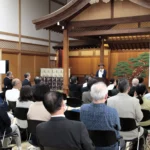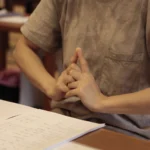The first Oomoto Incident: February 12, 1921 ~ May 17, 1927
On February 12, 1921, Oomoto Co-Founder Onisaburo Deguchi and several other Oomoto followers were arrested on suspicion of lese majesty and violation of the Newspaper Law. After spending 126 days in jail pending trial, Onisaburo was released on bail; he began dictating “Tales from the Spirit World” in the autumn of the same year. Though the Osaka court convicted, the judgment was later overturned by the Supreme Court, which determined, “There is a serious defect in the previous ruling.” The government appealed and the case was again retried. During the proceedings, the Emperor Taisho passed away leading to an amnesty.
The Second Oomoto Incident: December 8, 1935 ~ October 17, 1945
The Second Oomoto Incident illustrates a kind of religious oppression unparalleled in recent Japanese history. Under the influence of the military, the Japanese government confiscated the lands upon which Oomoto’s spiritual centers were located and destroyed every other facility. More than 3,000 Oomoto followers were arrested, 16 of whom died from torture and other suffering endured while imprisoned. Before the end of the Second World War, those charged were found innocent of violation of Japan’s Act for the Maintenance of Public Order. After the war ended, the charges of lese majesty were also dropped.
Oomoto suffered tremendous damage from this incident. Onisaburo, however, refused to demand reparations from the government explaining: “Now that the war has been lost, any compensation money from the government would basically be ‘blood taxes’ taken from the defeated people,” he said. Because Oomoto was oppressed in this way throughout the war, it is said that Oomoto is the only Japanese religious organization that lent no support or cooperation to Japan’s war efforts.
On December 30, 1945 the following statement appeared in the Osaka Asahi newspaper, taken from a press interview with Onisaburo at Yoshioka Onsen in Tottori prefecture:
I was under arrest since before the China Incident until the end of the Second World War. Beginning with our headquarters in Ayabe, over 4000 of Oomoto’s local chapters across the country were demolished. However, since our followers have continued to believe in the Oomoto doctrine, already — without any reconstruction — our organization is rebuilt.
I wish only for the peaceful unification of the universe. Within Oomoto many prophecies were made predicting the current state of Japan, and this is why we were suppressed.
Later, the beliefs of Shinto will probably change. There is much talk of Shinto as the national religion, but the interpretation commonly followed up to now was mistaken. Nothing differs in God even with Democracy. A mistake was forced on Japan: the real existence of the Divine was forgotten, and instead the people were forced to idolize a shrine convenient to the government’s own circumstances. The hardship that Japan has to endure because of its war defeat is only beginning, and will increase year by year — Japanese society will not recover until 1950, the Year of the Tiger.
Now Japan has completely lost all of its arms, and this brings a precious mission, as a pioneer for world peace. True world peace will be realized when the armaments of the whole world have been abolished, and this era is now drawing near.
[Onisaburo Deguchi, “The Yoshioka Interview”]
Oomoto as a Model
There is a teaching within Oomoto that states that Oomoto itself serves as a model, a miniature version of Japan and the world. “Because Oomoto in Ayabe is a place that aspires to become the great origin of the world, because everything that is within Oomoto is within the world, everything that happens within Oomoto will become a model for the world” (21st day of the 11th lunar month, 1917, Oomoto Divine Revelations)
In 1935, at the time of the Second Oomoto Incident, both of Oomoto’s Spiritual Centers at Ayabe and Kameoka were completely destroyed, as were all other Oomoto facilities across the country. The most sacred site in Kameoka, Gekkyu-den (The Lunar Palace), was blown up with dynamite. Ten years later, when Japan was faced with war defeat, the Japanese countryside looked exactly like Ayabe and Kameoka had looked ten years earlier. The American Army occupied the country, and all of Japan was under its rule. As a fulfillment of the oracle, the seized and destroyed sacred lands of Oomoto had become a “model” for Japan.
The Second Oomoto Incident was instigated in the early morning of December 8, 1935, when several hundred armed police began their mass arrest of Oomoto followers. At the same time, armed police also made a surprise raid on the local Oomoto chapter at Lake Shinji, in Matsue, Shimane prefecture, where Co-Founder Onisaburo Deguchi was staying. The Pacific War (World War II) began six years later with the surprise attack on Pearl Harbor, also in the early morning of December 8.
The Second Oomoto Incident came to an end on September 8, 1945, when, in accordance with the Supreme Court’s judgment, it was announced that Oomoto was innocent. World War II was officially concluded six years later with the signing of the San Francisco Peace Treaty, also on September 8.
Onisaburo, Sumiko and others were detained pending trial for six years and eight months (from October 12, 1935 until July of 1942). The Allied Forces also occupied Japan for six years and eight months (from September of 1945 until the end of April, 1952).
Closer inspection reveals corresponding dates for more events; there are too many of these parallel historical facts for them to be dismissed as mere coincidences. Within Oomoto’s history, examples like the ones above are too numerous to mention here.
The notion of Oomoto as a “model” also indicates Oomoto’s function as a pioneer. One aspect of this is that the activities that Oomoto promotes will later spread throughout Japan and the rest of the world.
Oomoto became an active supporter of interreligious cooperation in the late Taisho period (the early 1920s). Today, various kinds of exchanges between religions often take place, but in the 1920s this was a very new movement, and Oomoto was at the forefront. Oomoto was also at the vanguard of the movement opposing atomic and hydrogen bombs.
Another example of this facet of the ‘Oomoto as model’ phenomenon is how, under Naohi Deguchi much progress was made in emphasizing the great value of traditional Japanese culture. Now that fifty years have passed since the end of the war, a tremendous interest in traditional Japanese culture has developed amongst the general population of Japan and many people in foreign countries.
History of Oomoto



